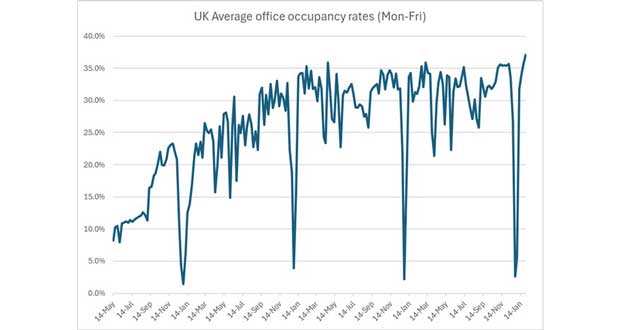The average UK office occupancy rates reached 37.1 per cent in the last week of January, the highest levels recorded since the lifting of lockdown restrictions, according to Remit Consulting.
The management consultant began analysing data taken from access control systems in major office buildings around the UK at the end of the first national lockdown in May 2021. Last week (w/e 31 January 2025), office occupancy rates reached an average of 37.1 per cent over the five working days – 1.2 percentage points higher than the previous best weekly average of 35.9 per cent, recorded in March 2024 and April 2023.
Since the COVID-19 pandemic, working patterns have been characterised by Mondays and Fridays being the quietest days of the week in terms of office attendance. However, last week’s record-breaking figure was boosted by a particularly high occupancy rate of 33.7 per cent on Monday, January 27th. This was the second consecutive Monday when the office occupancy rate topped 33 per cent.
Lorna Landells of Remit Consulting said: “The latest figures show a continued shift in office attendance patterns, with occupancy rates reaching their highest level in nearly five years. While hybrid working remains the norm, the steady increase in office attendance, particularly on traditionally quieter days like Monday, suggests that businesses and employees are finding greater value in in-person collaboration.
“Our ongoing research suggests that this indicates a longer-term adjustment in workplace behaviours as organisations refine their hybrid strategies to balance flexibility with the benefits of face-to-face engagement.
“The upward trend in office occupancy, which we have witnessed over recent months, is certainly encouraging. However, businesses continue to face the challenge of aligning workspace utilisation with evolving attendance patterns, ensuring they strike the right balance between operational efficiency and employee flexibility,” she added.
There are diverse views in the property sector regarding what constitutes maximum occupancy for offices, with some industry commentators suggesting that, due to holidays, external meetings, staff sickness and other operational issues, offices were only ever 60-80 per cent ‘full’ before the pandemic.
Previous research from the BCO suggested a figure of 60 per cent, while other market practitioners suggest a figure between 70 per cent and 80 per cent at peak times in the calendar, although this will have varied widely according to individual buildings and businesses. The graph below shows an adjusted figure to compare current figures with a possible pre-pandemic “80 per cent average office occupancy”.
On 27 February FMJ will be hosting a webinar in partnership with workplace management solutions provider, Matrix Booking, to discuss the challenges posed by managing hybrid work models, meeting sustainability targets, and dealing with economic pressures, which have long required a fine balancing act for Facilities Managers. This is set to become more complicated this year with the Government announcing plans to allow staff to work more flexibly.
The webinar will bring together the digital experts from Matrix Booking alongside a panel of workplace thought leaders to discuss how FMs can create the perfect balance.
Can’t make it no problem… Simply sign up below and after the webinar has been broadcast, we will send you a link to watch the recording. Register for the webinar by clicking here.






